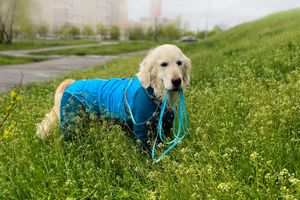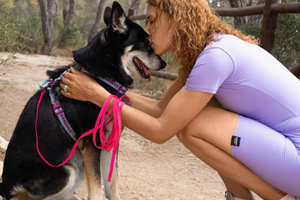In today's post, we'd like to continue this topic and talk a bit about safety measures while beach walking or swimming with your dog. Because safety always has to come first!
![]() Swimming is a high-performance physical activity. It's a great way to exercise your dog's muscles while their joints and spine do not receive any shock load. Therefore, swimming might be a suitable exercise even for growing puppies, old dogs, overweight dogs, dogs with arthritis, and spinal conditions. At the same time, swimming is an active cardio exercise, and you need to dose a "healthy amount" of swimming. For beginners, you may start with a few sessions of a few minutes each with a break between each short session. Also, give your dog some time to rest and literally catch their breath.
Swimming is a high-performance physical activity. It's a great way to exercise your dog's muscles while their joints and spine do not receive any shock load. Therefore, swimming might be a suitable exercise even for growing puppies, old dogs, overweight dogs, dogs with arthritis, and spinal conditions. At the same time, swimming is an active cardio exercise, and you need to dose a "healthy amount" of swimming. For beginners, you may start with a few sessions of a few minutes each with a break between each short session. Also, give your dog some time to rest and literally catch their breath.
![]() If you plan to use swimming as a part of physical rehabilitation for your dog with some health conditions, you should discuss it with your vet or physio to make a workout plan and follow it strictly.
If you plan to use swimming as a part of physical rehabilitation for your dog with some health conditions, you should discuss it with your vet or physio to make a workout plan and follow it strictly.
![]() As we said before, swimming is a serious load on the dog's cardiovascular system. If your dog has a diagnosed heart condition, or your dog's breed is in the risk group for predisposition to cardiovascular diseases, you should check it with a veterinarian specialist and make sure that such type of physical activity will be suitable and safe for your dog.
As we said before, swimming is a serious load on the dog's cardiovascular system. If your dog has a diagnosed heart condition, or your dog's breed is in the risk group for predisposition to cardiovascular diseases, you should check it with a veterinarian specialist and make sure that such type of physical activity will be suitable and safe for your dog.
![]() Not all dogs are born to be exceptional swimmers. Some dogs are just really lame at swimming, and their attempts to swim look more like a fight for survival. These dogs may need some additional safety measures such as safety flotation vests. The correct safety vest must cover the dog's back from the withers to the base of the tail. They will help keep the dog's body parallel to the surface of the water. The short safety vests that only cover half of the dog's back don't make a lot of sense really.
Not all dogs are born to be exceptional swimmers. Some dogs are just really lame at swimming, and their attempts to swim look more like a fight for survival. These dogs may need some additional safety measures such as safety flotation vests. The correct safety vest must cover the dog's back from the withers to the base of the tail. They will help keep the dog's body parallel to the surface of the water. The short safety vests that only cover half of the dog's back don't make a lot of sense really.
![]() Swimming seems to be a great way to cool down your dog during the summer heat, BUT! If your dog previously ran a lot, or you walked for a long time to the beach under the scorching sun, do not let it dive completely into the water instantly. Let your dog rest in the shade and cool down for a bit, then you may let it wet its paws and belly, and only after this, you may let your dog swim. Remember that a sharp drop in temperature (a heated dog abruptly dived entirely into cool water) can cause vasospasm and do more harm than favor.
Swimming seems to be a great way to cool down your dog during the summer heat, BUT! If your dog previously ran a lot, or you walked for a long time to the beach under the scorching sun, do not let it dive completely into the water instantly. Let your dog rest in the shade and cool down for a bit, then you may let it wet its paws and belly, and only after this, you may let your dog swim. Remember that a sharp drop in temperature (a heated dog abruptly dived entirely into cool water) can cause vasospasm and do more harm than favor.
![]() If your dog is a little bit manic about swimming and may spend hours in the water, you need to manage its activity. Some dogs may have sore muscles or limber tail syndrome after excessive swimming sessions. It's definitely not a deadly condition, and it will pass after a few days of rest, but still, it's not healthy.
If your dog is a little bit manic about swimming and may spend hours in the water, you need to manage its activity. Some dogs may have sore muscles or limber tail syndrome after excessive swimming sessions. It's definitely not a deadly condition, and it will pass after a few days of rest, but still, it's not healthy.
![]() Be aware of hot sand and pebbles. It may burn dogs' paws. If you put your hand or a bare foot to the sand and can't keep it there for more than a few seconds because of a burning sensation, it's definitely too hot for your dog's paws as well.
Be aware of hot sand and pebbles. It may burn dogs' paws. If you put your hand or a bare foot to the sand and can't keep it there for more than a few seconds because of a burning sensation, it's definitely too hot for your dog's paws as well.
![]() Dry your dog's fur completely. Especially if you have a long-haired dog. Systematically damp fur may cause some skin conditions such as fungus or weeping eczema.
Dry your dog's fur completely. Especially if you have a long-haired dog. Systematically damp fur may cause some skin conditions such as fungus or weeping eczema.
![]() Stay safe and healthy!
Stay safe and healthy!
![]() Have lots of fun on your beach walks!
Have lots of fun on your beach walks!







